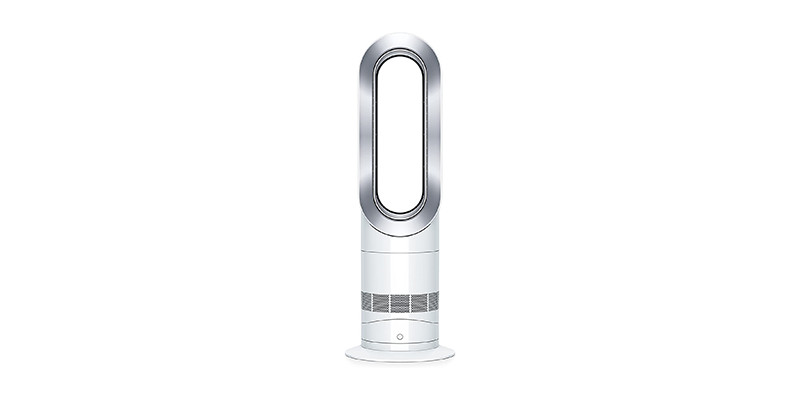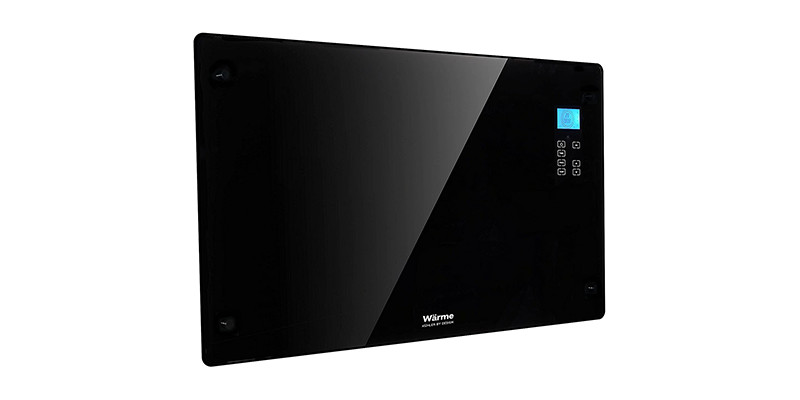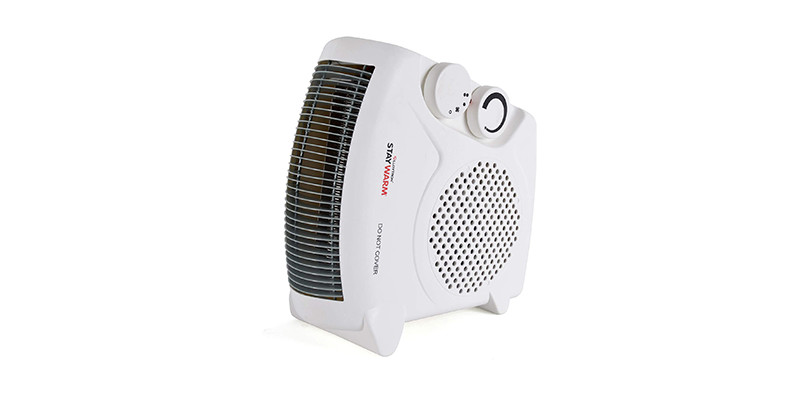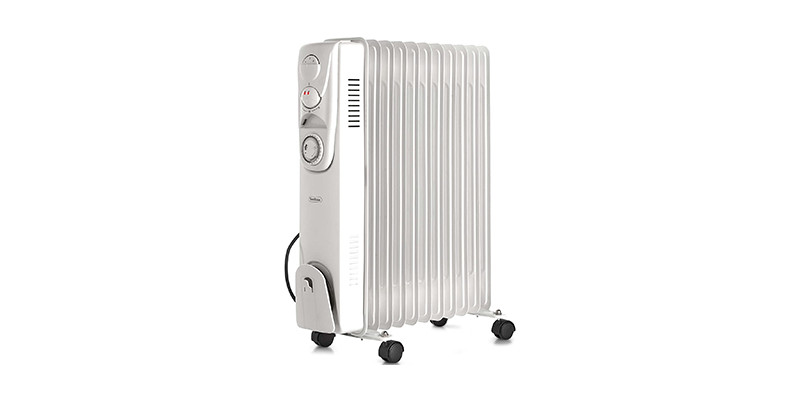As temperatures plummet, you’ll feel the need for a little bit of extra heat. Or a lot more. But if you have no electric heater at hand and you’re just contemplating the idea of buying one, don’t break a sweat!
We’ll help you find a model that fits your needs and your budget. Also, importantly, that will raise your room temperature without raising your electricity bill too much.
Soon enough, you’ll love the benefits of keeping your thermostat at a lower setting while adding a pleasant warmth to a single room in your house.
So, in this buying guide, you’ll get familiarized with some of the top electric heaters on the market.
Sizes and styles, special features, convenience during operation, and other impactful details are all taken into account.
Without further ado, here’s what to consider when doing the research for a space heater.
Best Electric Heaters
| # | PREVIEW | Product | |
|---|---|---|---|
| 1
Best For Higher Budgets
1Dyson AM09 Fan Heater
|
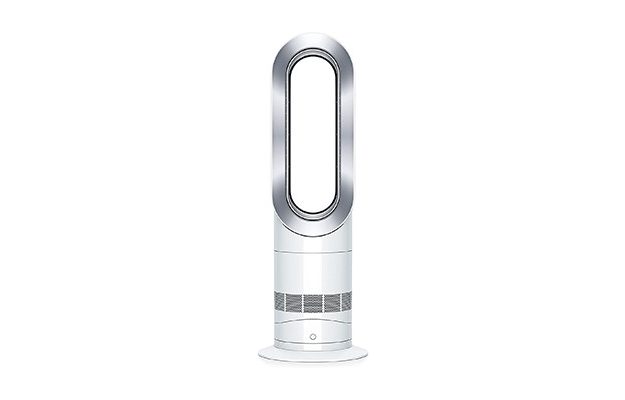
|
|
|
|
|
|||
| 2 |

|
|
|
|
|
|||
| 3
Best For Low Budgets
3StayWarm Upright and Flatbed Fan Heater
|
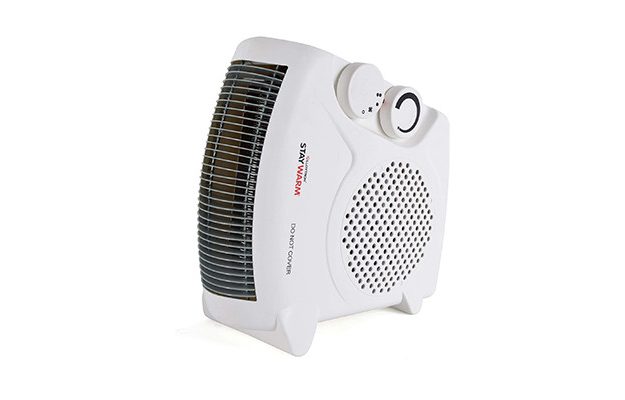
|
|
|
|
|
|||
| 4
Best Overall
4VonHaus Oil Portable Electric Heater
|

|
|
|
|
|
|||
| 5 |
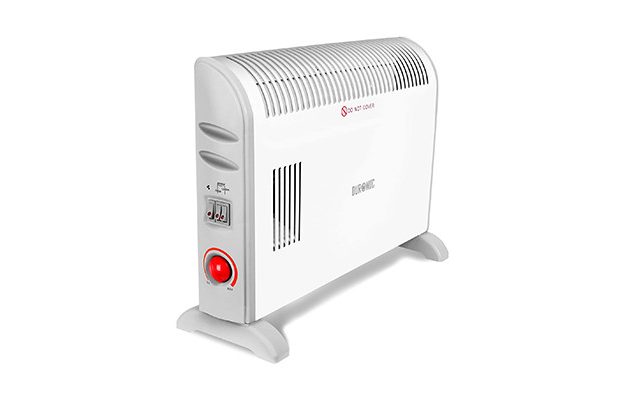
|
|
|
|
|
|||
1. Dyson AM09 Fan Heater
- Electric heater with 33- to 99-degree temperature setting.
- Works with an intelligent thermostat to monitor and maintain room temperature.
- Features patented air multiplier technology for heat projection.
- Built with an enclosed heating element and tip-over automatic shut-off.
Dyson’s AM09 fan heater with Jet Focus control can easily turn into your favourite personal heater. At the tap of a button, you make it send the airflow anywhere, from desktop level to tabletop or floor.
With smooth oscillation, precise room heating, and air multiplier technology that amplifies the surrounding air, it works like no other heater. Instead of relying on blades and giving that choppy air effect, it offers you a smooth, uninterrupted airflow stream.
The remote control is just perfect, practical, with a sleek curved design and a magnetized cover so you can easily attach it to the heater.
Easy to clean, safe to operate – with automatic shut off when it tips over – and with no burning smell, this heater can play both sides, also acting as a cooler in summer months.
Specifications
Pros
- Versatile and effective electric heater.
- Heats the room fast and evenly.
- Facilitates energy-efficient operation.
- Designed with safety in mind.
Cons
- Comes with a high price tag.
- Fan gets a tad noisy on the higher settings.
2. Wärme Designer Electric Wall Heater
- Electric unit with 2 KW output heat for rooms of up to 22 m2.
- Includes wall mount bracket and kit in the box.
- Features patented technology and programmable thermostat.
- Waterproof design and IP22 rating.
With the Wärme Designer Electric Wall Heater you get an ultra-slim, stylish 2 Kw heater. It comes with a wall bracket in the package. Yet it can also be used as a floor-standing unit.
A low-energy panel heater radiator at its core, it can quickly and easily heat rooms of up to 22 m2 and runs with low costs.
The digital programmable thermostat lets you set a weekly heating cycle, as per your preferences. But just in case you want to get toasty-warm really quickly, it features an instant-heat mode.
The design is so elegant that it almost makes you think of a fancy TV. While the operation requires nothing more than plugging it in and selecting a programme.
The 2-year warranty and no-maintenance operation add up to its long list of attractive features!
Specifications
Pros
- Effective electric heater.
- Compact design, fits both floor & wall setup.
- Programmable, easy to use.
- Requires no maintenance.
Cons
- Usage instructions could be a bit clearer.
- No auto shutoff function.
3. StayWarm Upright and Flatbed Fan Heater
- Works with a variable thermostat and features frost-watch protection.
- Designed to sit either in flatbed or in upright position.
- Comes with 2 heat settings, 1000/2000 W.
- Built-in dual auto safety cut-off.
If you’re looking for a budget electric heater that can quickly heat up a room, this 2000 W model from StayWarm is a more than decent option. It can sit horizontally or vertically, working at either 1000 or 2000 W.
Small and compact, with simple but intuitive controls, the heater features even frost-watch protection. While for everyday use, the power indicator and the variable temperature thermostat will come in handy.
Despite being made of plastic, its case is flame retardant. On the inside, safety is doubled with an automatic power-cut function. Following some user complaints regarding its plug’s reliability, the manufacturer seems to have introduced a new type of plug for enhanced protection.
As a budget option, it comes at an outstanding price. But its 3-year warranty makes it stand out even more. So, it is well worth the attention!
Specifications
Pros
- Versatile heater that can sit either vertically or horizontally.
- Multi-use, hot and cool operation.
- Variable thermostat gives you more flexibility.
- Comes with safety features and a 3-year warranty.
Cons
- Cable is only 1 meter long.
- Budget fan heater with limited capabilities.
4. VonHaus Oil Portable Electric Heater
- Powerful oil radiator with 11 fins for rooms of up to 28 m2.
- 24-hour timer, adjustable thermostat, and 3 power settings.
- Automatic overheat protection, thermal cut-off, and safety tip-over.
- 1.5m power cord and designed with cable-tidy.
With the enticing promise to keep the cold at bay, VonHaus’ 2.5 KW oil-filled electric heater makes a good portable option. Compact, with 11 oil fins and 3 heat settings, it features caster wheels and a handle for easy manoeuvring.
For a well-insulated room of up to 28 m2, it should work wonders. Not only will it keep it comfortably warm, but it can do it well before your arrival, as it is easily programmable.
Basically, it comes with a 24-hour timer with a manual dial. You can pre-set it to turn On/Off at certain hours. With the added benefit of selecting between low, medium, and high heat.
Counting the top-over switch, the built-in overheat protection, and the option to extend the warranty to 2 years by registering the product, you’re looking at a really good deal.
Specifications
Pros
- Easy to use, versatile, adjustable settings.
- Practical design, easy to carry around.
- Comfortable 2-year warranty.
- Lots of safety features.
Cons
- Power cable could be a bit longer.
- Suitable for occasional, rather than permanent use.
5. Duronic HV120 Convector Heater
- Convector heater with turbo fan and built-in thermostat.
- 3 heat settings: 750 W, 1250 W, 2000 W.
- Facilitates both wall-mounted and free-standing operation.
- CE approved and with 1.8 m power cable.
This convector heater with a turbo fan, from Duronic, gives you the best of two worlds: instant fan-propelled heat and lasting, all-around background heat from the convector.
With 3 different heat settings and temperature dial, it is super-easy to set up and to control. The fan, which helps to spread the heat faster, can also be used independently.
So, in summertime, this heater can act as a fan cooler, too. Yet for all-year use, one can either have it free-standing or mount it on the wall.
Pretty straightforward to assemble, it is also impressively lightweight and designed for easy transportation around the house, in case you choose not to hang it on a wall.
CE-approved, with a built-in thermostat that prevents over-consumption, it is a safe and reliable convector heater. You’ll want it on your shortlist!
Specifications
Pros
- Works for both heating and cooling a room.
- Heats up faster than oil-filled electric heaters.
- Features turbo fan for increased heat output.
- Lightweight and with portable design.
Cons
- Somewhat loud when the turbo fan runs.
- Assembly quality could be improved.
Electric Heater Buying Guide
Oil VS Water
Most of the new, modern electric heaters rely on oil as a heating agent. However, there are some older models of water electric heaters, too. The reason why oil is preferred to water is that it stores more heat and dissipates it slower.
In other words, oil electric heaters are more energy-efficient. Because oil cools much slower compared to water, an oil heater will work less and with fewer warming cycles.
Water Electric Heater
Water electric heaters are usually part of a more elaborate heating system. They are, in fact, called radiators, and have a well-defined working principle: drawing heat from water and using that heat to warm up the air that surrounds them.
Water radiators are one of the oldest heating options. They are commonly encountered even today, both in older residences and in commercial buildings. But they are all fixed, wall-mounted, and don’t provide you with the portability that electric oil heaters have.
Electric Oil Heater
Oil is the most common heating agent you’ll encounter with the portable electric space heaters on the market. Its direct competitor would be a heater with an exposed-element, but oil heaters win over the exposed-element ones because oil creates a very effective heat sink.
Effective and cheaper to run, electric oil heaters provide silent, odour-free heating. The typical design involves metal fins and they also come with adjustable thermostats, programmable timers, ECO modes, and caster wheels for easy manoeuvring. We also have a review for best oil filled radiators.
Best Type of Electric Heater
All electric heaters must be plugged into a power source to start generating heat. The type of heating element they rely on, and their best intended use, however, can make a significant difference in terms of efficiency.
Here’s what to look for in the best type of electric heater, depending on where you plan to use it:
Electric Fan Heater
Electric fan heaters are more of an additional heat source rather than a main heating option. The fan will speed up the circulation of the hot air, which means it will also heat up the room faster.
Typically, a fan heater is portable and comes with some practical features like climate control and oscillating settings.
Electric Patio Heater
Electric patio heaters are designed to operate in colder environments. While they may take longer to heat up, they do generate a serious amount of heat. This, of course, implies a higher running cost.
On the plus side, an electric patio heater is effective, provides a generously wide-ranging heat, and it isn’t that expensive to buy, either. The drawbacks, however, are the lower energy efficiency and the somewhat longer time you need to wait until they fully warm up your patio.
Electric Stove Heater
Electric stove heaters resemble amazingly well to a real fire. But they spare you from the costs of open-fire heaters. Not to mention that they certainly don’t involve any complications like the need to install and maintain a flue, or pipework.
Thanks to its power source, an electric stove heater also comes with the benefit of being easy to set up anywhere you want in the home. You’ll also get to pick from a wide range of models and styles, to better fit your home décor.
Electric Wall Heater
Electric wall heaters are the type of appliance that only requires you to plug it in and, perhaps, set up a heating mode as per your desire. They are compact and usually with a stylish look. Most of them can work either wall-mounted or free-standing.
An electric wall heater is both energy-efficient and eco-friendly. It has the advantage that it can sit up on any wall, away from small children’s access, in a position from where heat will dissipate even better. Plus, it is ideal for heating a small room, be it a bedroom, bathroom, or home office.
Efficiency
All electric heaters for home turn all their energy into heat, which enables the manufacturers to label them as 100% efficient. However, their cost-effectiveness will vary depending on the functioning principle, but also on where you place them while in use.
The most efficient electric heater is a small, portable unit with either oil or halogen, for example a halogen heater. By contrast, the fan heaters and the bar fires are a tad more expensive. If you want to make comparisons, always consider their power rating.
The higher the power rating of the electric heater you consider buying, the more it will cost to keep it running. That’s why you’ll want to look at models with two or three power levels, rather than the ones that only work at full power all of the time.
Features
From looks, quality and style, to control options, heating power, and energy efficiency, there are plenty of features that can make an electric heater more or less appealing. Below, we’ll discuss some of the most important ones.
Timer
A timer is one of the most important control options you’ll want to have in your electric heater. It basically determines for how long or between what intervals the heater will work. Once you set it up, it will free you from doing any tweaks, the same as panel heaters.
You can use it to heat a space in advance, like your bedroom before you come home, or your bathroom early in the morning, around the time you usually wake up.
Alternate Mods
Alternate modes are the next level after the simple electric heaters that only let you set the power and a heating level. The more alternate modes your unit features, the more versatile it is. Apart from convenience, these modes also allow you to set the heating on auto-pilot and avoid wasting energy.
Some of the most popular alternate modes are the anti-frost (which makes sure the temperature in the room won’t drop below a particular value) and the economy mode (which implies really low-energy operation).
Wireless Technology
Known to add extra comfort, wireless technology is often paired with electric heaters in the most natural possible way.
Typically, a wifi electric heater will provide all the features you want, with the added convenience of being able to control it remotely.
Instead of keeping the heater’s remote control at hand all the time, you can use your phone and a dedicated app, when you’re at home.
Power
Most portable electric heaters you’ll find on the market have a power output of 2000 or 2500 W, similar to a conservatory heaters. As mentioned above, however, the best models actually give you a bit more control, with two, sometimes even three power levels.
A 2000 W electric heater may work just like that, at maximum capacity. But at the same time, might be able to turn into a low power heater at the push of a button, going down to as little as 750 W.
Size
Electric heaters are generally built in a small, compact format, so they can make a portable choice and be easily moved around the house. If you want something bigger you can always go for an electric fire.
60 x 40 x 20 cm is an average size for a portable space heater. But a really small electric heater could measure even just 25 x 15 x 25 cm.
Some models are wider and flatter, while others are smaller and bulkier.
Pricing Range
Like with any other appliance, the pricing range will vary a lot. For those who only settle for top-of-the-range products, paying as much as £400 for an electric heater will feel natural.
By contrast, a budget-friendly electric heater with limited capabilities can be surprisingly cheap, as in £25 cheap!
Frequently Asked Questions

By far, the cheapest electric heater to run is an infrared heater. It provides the lowest wattage preheat, and it is guaranteed to keep your electric bill low.
The next-best cheap electric heater to run would be an oil-filled model. That’s because of the long-lasting heat that oil facilitates, which allows the unit to make the most out of the electricity it uses.

If you don’t want to use an online calculator, you can calculate the electric heater size you need on your own.
- First, find out how many square meters your room has – the room you intend on using the heater for. Multiply its length and width in meters, as in 6 metres x 3 meters = 18 m2.
- Then, correlate it with the required power, which is around 100 W for 1 m2 in a living room and approximately 75 W for 1 m2 in a bedroom.
If your room has 18 m2 like in the example from above, and you need 1000 W for 10 m2, a 2000 W electric heater should be able to keep it warm without too many complications.
Of course, you should also consider factors like the insulation of the room and whether it has any exterior walls facing the North. If that’s the case, you might want a slightly more powerful electric heater, just to be on the safe side.
Our Verdict
The best electric heater can be useful in more ways than you can imagine. This type of standalone heater can either complement or replace central heating.
On the one hand, it can work to generate focused, localized heat in a small area. Like in a room outside your house, say an outside office.
On the other hand, it can maintain a constant temperature in a room of your house, for someone in need. Whether you’re ill, elderly, or suffering some temporary mobility limitations, keeping an optimal temperature with minimal efforts is highly desirable.
To top it off, having a couple of space heaters around the house can prove quite handy in emergency situations, like a malfunction of the boiler.
Luckily, you know your options and you know what to look for when choosing the best electric heater for any of the above-mentioned circumstances.

